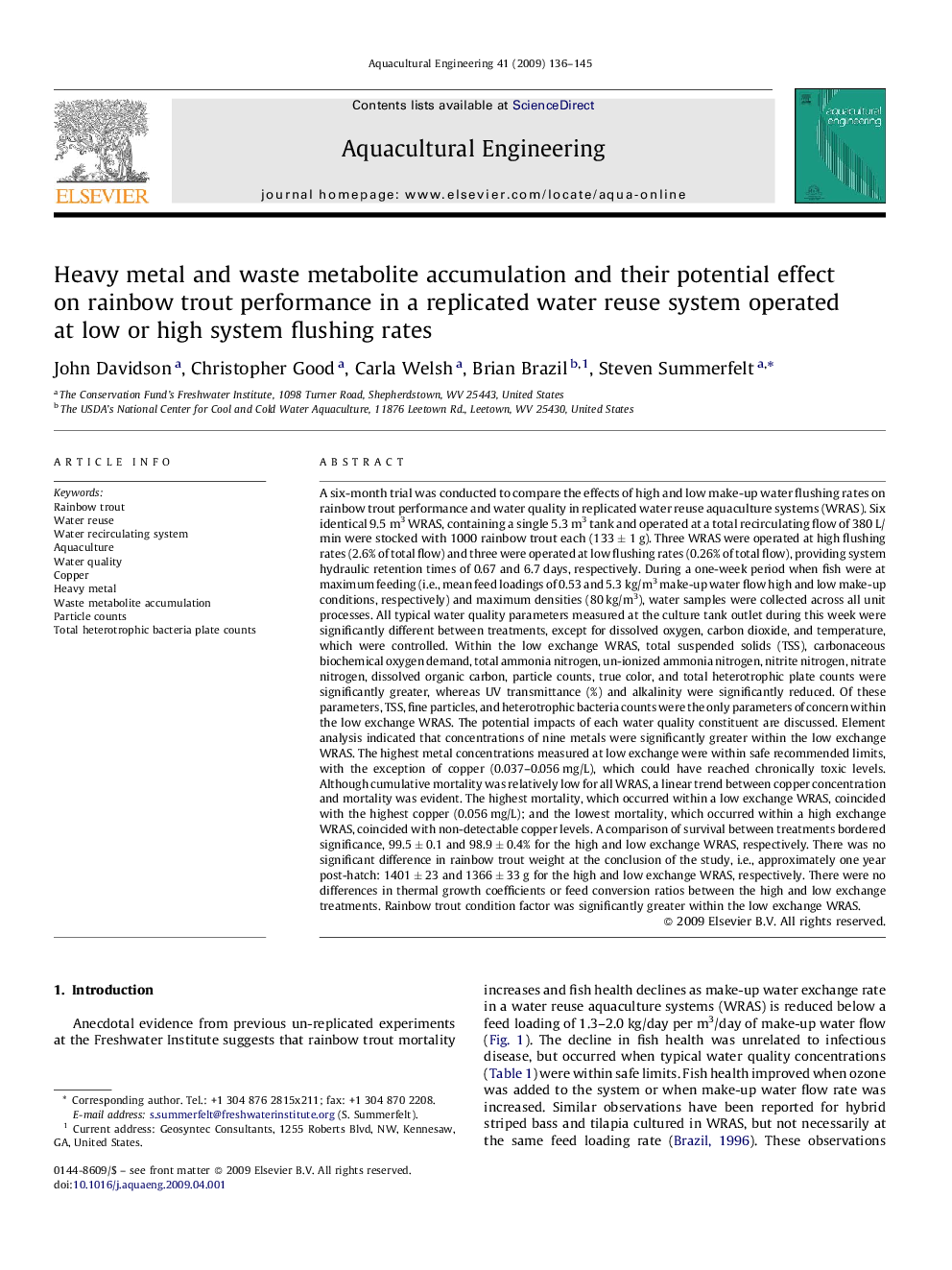| کد مقاله | کد نشریه | سال انتشار | مقاله انگلیسی | نسخه تمام متن |
|---|---|---|---|---|
| 6381524 | 1324094 | 2009 | 10 صفحه PDF | دانلود رایگان |
عنوان انگلیسی مقاله ISI
Heavy metal and waste metabolite accumulation and their potential effect on rainbow trout performance in a replicated water reuse system operated at low or high system flushing rates
دانلود مقاله + سفارش ترجمه
دانلود مقاله ISI انگلیسی
رایگان برای ایرانیان
کلمات کلیدی
موضوعات مرتبط
علوم زیستی و بیوفناوری
علوم کشاورزی و بیولوژیک
علوم آبزیان
پیش نمایش صفحه اول مقاله

چکیده انگلیسی
A six-month trial was conducted to compare the effects of high and low make-up water flushing rates on rainbow trout performance and water quality in replicated water reuse aquaculture systems (WRAS). Six identical 9.5 m3 WRAS, containing a single 5.3 m3 tank and operated at a total recirculating flow of 380 L/min were stocked with 1000 rainbow trout each (133 ± 1 g). Three WRAS were operated at high flushing rates (2.6% of total flow) and three were operated at low flushing rates (0.26% of total flow), providing system hydraulic retention times of 0.67 and 6.7 days, respectively. During a one-week period when fish were at maximum feeding (i.e., mean feed loadings of 0.53 and 5.3 kg/m3 make-up water flow high and low make-up conditions, respectively) and maximum densities (80 kg/m3), water samples were collected across all unit processes. All typical water quality parameters measured at the culture tank outlet during this week were significantly different between treatments, except for dissolved oxygen, carbon dioxide, and temperature, which were controlled. Within the low exchange WRAS, total suspended solids (TSS), carbonaceous biochemical oxygen demand, total ammonia nitrogen, un-ionized ammonia nitrogen, nitrite nitrogen, nitrate nitrogen, dissolved organic carbon, particle counts, true color, and total heterotrophic plate counts were significantly greater, whereas UV transmittance (%) and alkalinity were significantly reduced. Of these parameters, TSS, fine particles, and heterotrophic bacteria counts were the only parameters of concern within the low exchange WRAS. The potential impacts of each water quality constituent are discussed. Element analysis indicated that concentrations of nine metals were significantly greater within the low exchange WRAS. The highest metal concentrations measured at low exchange were within safe recommended limits, with the exception of copper (0.037-0.056 mg/L), which could have reached chronically toxic levels. Although cumulative mortality was relatively low for all WRAS, a linear trend between copper concentration and mortality was evident. The highest mortality, which occurred within a low exchange WRAS, coincided with the highest copper (0.056 mg/L); and the lowest mortality, which occurred within a high exchange WRAS, coincided with non-detectable copper levels. A comparison of survival between treatments bordered significance, 99.5 ± 0.1 and 98.9 ± 0.4% for the high and low exchange WRAS, respectively. There was no significant difference in rainbow trout weight at the conclusion of the study, i.e., approximately one year post-hatch: 1401 ± 23 and 1366 ± 33 g for the high and low exchange WRAS, respectively. There were no differences in thermal growth coefficients or feed conversion ratios between the high and low exchange treatments. Rainbow trout condition factor was significantly greater within the low exchange WRAS.
ناشر
Database: Elsevier - ScienceDirect (ساینس دایرکت)
Journal: Aquacultural Engineering - Volume 41, Issue 2, September 2009, Pages 136-145
Journal: Aquacultural Engineering - Volume 41, Issue 2, September 2009, Pages 136-145
نویسندگان
John Davidson, Christopher Good, Carla Welsh, Brian Brazil, Steven Summerfelt,